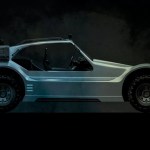Last week Overland-E, the maker of the conventionally powered overlander ATV (all-terrain vehicle) based on the original Volkswagen Beetle chassis, showed a concept of its second-generation vehicle. The all-terrain electric Gen2 is a “ground-up designed” vehicle that offers a more refined driving experience thanks to more car-like operation and bodywork. It also offers an eye-popping range of over 750 mi (1210 km) enabled by recent advancements in battery technology.
“We’re incredibly excited to launch the Gen2,” said Arron Rawding, Co-founder and CEO. “We’ve got a fantastic team together and we are looking forward to getting the vehicle built. Having access to advanced EV tech is a hugely important element in ensuring that Overland-E will become a sustainable, net-zero business and we take on board that traditional fossil fuels will be banned from 2030.”
Overland-E has already gotten the attention and funding of Pario Ventures, a venture capital fund based in London, New York, and Brussels. Founded by David Murray-Hundley and Kevin Doyle, the company has made investments in other notable automotive startups such as Rivian, Sono Motors, Atlis Motor Vehicles, MyCarDirect, and Riversimple.
“It’s exciting to see the progress the team is making,” said Murray-Hundley, CEO of Pario Ventures. “The Gen2 vehicles were inspired by the original VW buggy vehicles that we built, but we recognized that things move on in life and that we have to adapt. I am also excited that elements of this vehicle will be built and manufactured in the UK, but also because we are trying to remain net-zero, that we will have to manufacture in local markets like the U.S.”
Other investors and customers can become part of the company by investing through a crowdfunding campaign.
Overland-E is based in Banbury and Birmingham in the UK. Its origin goes back to when Rawding met Dave Fisher in 2017 when researching the possibility of creating a road-legal desert patrol vehicle variant for recreational use. After many months of design and development, the pair joined forces and established Kingfisher Overland, now Overland-E.
The company’s first conventionally powered vehicle, the Mk1 overlander, is based on a Volkswagen Beetle standard chassis with an air-cooled internal-combustion engine. It comes in an Urban version, built for streets, and the Explorer, built for “adventure.”
Like most air-cooled enthusiasts, the pair was initially “somewhat repulsed” by the possibility of converting to electric. However, with advances in technology and the availability “of some pretty awesome pieces of kit,” the company’s founders decided to install an electric motor into their Urban overlander, and the Gen2 was born.
The market potential for EVs was also a motivator for the company’s leaders. They cite that the global electric ATV and UTV (all- and utility-terrain vehicle) market that accounted for nearly $469 million in 2019 is anticipated to see a compound annual growth rate of more than 23% from 2020 to 2030 to reach $4.3 billion by 2030.
The company is looking to raise $5 million to develop the Gen2, planning for its all-terrain skateboard to support a number of vehicle models and applications. Beyond personal use, the company is keen to sell the vehicle to the military and participate in motorsport, especially in the U.S., where off-road desert racing is a major sport. Major strategic partners are Sparco and Expeds International.
As with the Mk1, the Gen2 comes in two versions. The Explorer is built for off-road duty, capable of “going anywhere over anything.” Its interior is more practical, durable, and waterproof, and can be jet washed out at the end of an adventure. The Urban is built for the city, with a more refined and luxurious interior.
The new vehicle is engineered to carry an incredible payload of 1500 kg (3300 lb). An integrated roof storage system enables equipment to be strapped to the roof and trunk, maximizing space inside for people. Interestingly, the side storage bins can also be used for more batteries for longer-range models. The Explorer also has a simple winch to get out of off-road difficulties.
Prototypes of both vehicle versions are planned for completion by the 4th quarter of 2022, with production versions available in June 2023.
- Overland-E Gen2 Explorer.
- Overland-E Gen2.
- Overland-E Gen2 in Urban and Explorer versions.
- Overland-E Gen2 Explorer render in the desert.
- Overland-E Gen2 Explorer.
- Overland-E Gen2 interior.
- Overland-E CEO Arron Rawding.
- David Murray-Hundley’s Pario Ventures is an investor in Overland-E.







































































































